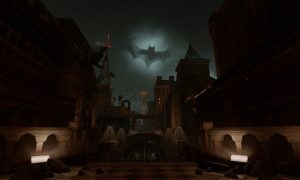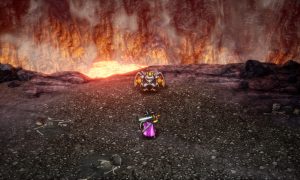
The first thing you’ll notice about Guacamelee! is just how damned funny everything is.
Set in a Spanglish version of Mexico, we are privy to the life of one Juan Aguacate, an agave farmer. As he visits El Presidente’s Daughter (yeah, that’s her name), his town is suddenly besieged by Calaca, an “Evil Charro Skeleton.” He defeats Juan, kidnaps the Daughter, and whisks her away into the Mexican Land of the Dead in order to unite both his world and our world. Juan is left for dead, and all seems hopeless — until he finds a legendary Luchador mask, granting him the powers he needs to take Calaca down once and for all.
[singlepic id=11534 w=320 h=240 float=left]All along your six-or-so-hour-long Metroidvania adventure, you’ll notice that Guacamelee is as much a love letter to videogaming as Fez, Super Meat Boy, or other similar indie titles of recent memory. A store in the main hub village is called ¡Viva Piñatas! There are posters referencing other luchador fighters like “El Linko” (complete with green felt cap), “Los Super Hermanos,” and “Los Casa Crashers.” Even the statues where Juan gets his powers look oddly like Metroid’s Chozo statues, and they’re watched over by a goat-turned-geriatric protector who constantly hits on Juan’s mother. Like Super Meat Boy, all of these references are endearing and legitimately hilarious, rather than pandering or annoying. Clearly, the developers over at Drinkbox Studios grew up loving video games, and this is their opportunity to show off that affection.
Underneath this hilarious and brilliantly stylized exterior lies a beast of a game, one that will test your mettle more than most other games of its ilk. In order to finally confront Calaca and take him down, you’ll have to navigate each of the several different areas — forests, towns, mountains, and the like — by running, jumping, and using your newly found powers in rapid sequence to make it to the next objective. True to Metroidvania form, you’ll notice barriers along the way that will only open when you finally have the right power available to you, encouraging you to go back through previously conquered areas to find additional health power-ups or other secrets.
Along the way you’ll also be able to switch dimensions, hopping back and forth between the Land of the Living and the Land of the Dead. Each world is an exact copy of itself, save for some hidden doors and glowing platforms that appear in one world, and not in the other. The transformation occurs at the press of a button, and it’s a really cool effect to not only see the world change before your eyes, but also hear the music warp and distort to match the world you’re in.
[singlepic id=11542 w=320 h=240 float=right]Unlike other Metroidvania clones, Guacamelee! has a surprisingly deep melee combat system to complement its exploration. The new moves that Juan learns can all be chained together in rather impressive form, each beautifully hand-drawn animation blending right into the next. As the enemies’ health gets depleted, Juan can grab on to them and perform a handful of different suplex moves, launching baddies into the air and slamming them into others, allowing for even bigger combo chains. You can get through most encounters by mashing buttons, but Guacamelee! rewards expert precision by granting monetary rewards for higher combos. On top of that, many enemies have shields that can only be destroyed by attacking them with specific special moves, adding further layers of nuance to an already entertaining combat system.
I keep referencing Super Meat Boy because that’s the one game I kept thinking back on as I pushed through the harder sections of the game — and Guacamelee! gets difficult. Many of the levels’ later sections (and most of the areas that lead to its hidden secrets) require absolutely perfect timing and precision, tasking you with perfectly chaining long strings of Juan’s moves together to navigate a winding path lined with buzz saws. One wrong move in these sections means starting all the way at the beginning. Later boss fights not only require an absolute memorization of all moves learned to that point, but they also need lightning quick reflexes and pattern recognition in order to move past them. One boss killed me at least a few dozen times before I finally got the hang of it and was able to defeat him and continue on my quest.
Its difficulty is probably one of the best parts about Guacamelee! Much like Super Meat Boy, the sheer challenge of everything never feels cheap — the controls are fluid, the jumping is precise, and all enemies have clear tells that can be easily responded to, as long as you have the ability to react to everything on screen. Each failure is an opportunity to learn, to get better, and to finally get your fingers to perform some serious Judo to make it through each level. Counterbalancing the challenge are some incredibly fair checkpoints and abundant shop placement — which not only let you buy new moves, but also refill your health — meaning each death or misstep never sets you back more than a screen or two.
[singlepic id=11543 w=320 h=240 float=left]In fact, the only real complaint that I have about Guacamelee! is one of the weirdest bugs I’ve seen yet. The final boss was giving me a very hard time — I couldn’t seem to figure out how to dodge some of its heaviest hitting super moves. I died about ten times, slowly figuring out how to maneuver around these attacks, and just when I felt like I was getting the hang of it — the boss stopped attacking me. He just sat there, letting me pummel his face into dust. It made the last fight much more anti-climactic than it should have been, and was made even more frustrating when, after I had gone to fight the boss again after finding most of the other hidden items, the same weird glitch showed its head a second time. Hopefully Drinkbox has a patch in the works, but as it stands, it’s an odd blemish on an otherwise polished game.
The Vita Connection
With a single purchase, you’ll get both the PS3 and Vita versions of the game. Guacamelee! translates perfectly to the handheld, with nothing lost in the way of visuals or controls. Plus, transferring saves to or from the Cloud is easy — just go to the options menu and hit the appropriate button. Once again, Sony is proving that the Vita can have a place within the gaming ecosystem, and they should be commended for continuing to support this feature.
Guacamelee! wins on so many fronts that any glitch in the system is trivial compared to the overall package. Drinkbox has crafted a brilliantly unique world on top of a platformer that combines the best of the classics, along with a few of its own ideas — things like two player local co-op is a feature I don’t think I’ve ever seen in a Metroidvania game, and I challenge more developers to try to include it. Guacamelee! is so sure of itself, and has got so much style to spare, that you can’t help but fall in love while trying to master its every complexity. If you’re a fan of video games, you’d be doing yourself a disservice not picking this up immediately.
I've been gaming since my dad made the bad decision of buying me a Nintendo when I was four years old. Every day I'd find myself with my face glued to a TV screen, punching away at buttons, getting furious with Bowser, Dr. Wily, and those freakin' birds in Ninja Gaiden. Since then I have failed to get my parents to play any board game with me, I sold my full copy of Earthbound with box and guide for $300 to some dude in Austria for rent money, and I still believe in Nintendo even after all these years.

See below for our list of partners and affiliates:
























